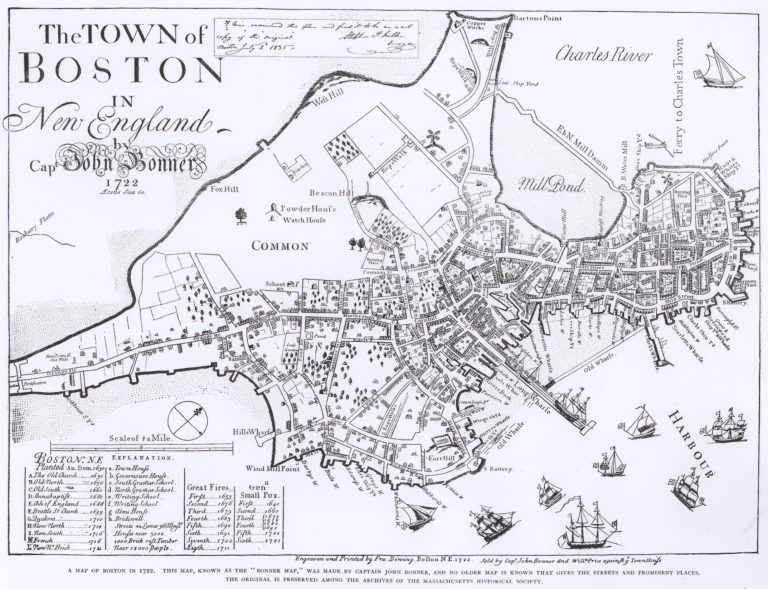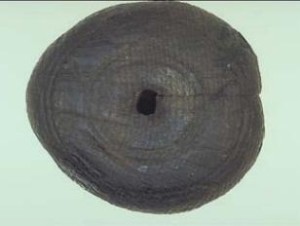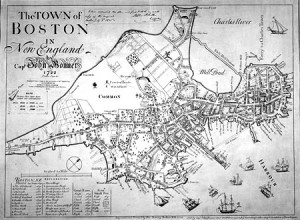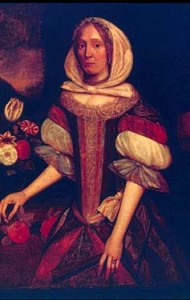Big Dig, Little Dig, Hidden Worlds: Boston

Baltimore | Boston | Charleston | Chicago | Havana
| Lima | Los Angeles | Mexico City | New Amsterdam | New Orleans
Paramaribo | Philadelphia | Potosi | Quebec City | Salt Lake City
Saint Louis | Santa Fe | San Francisco | Washington, D.C.
For more than a decade Bostonians have watched the progress of the Big Dig, described on the project’s official Website as a public works challenge on the scale of the Panama Canal, the Trans-Alaska Pipeline, and the English Channel Tunnel (Chunnel). Thanks to an infusion of federal highway dollars, an unsightly elevated highway that has long separated the city’s North End from its commercial and civic core is about to be replaced with an eight-to-ten-lane underground highway. To create the massive tunnel, contractors removed sixteen million cubic yards of soil and underground debris.
Fewer people know about the little digs that preceded Boston’s Big Dig. Following federal guidelines, the Central Artery project allotted roughly four million dollars in the early 1990s for archaeological explorations in areas thought to be rich in early history and likely to be destroyed by construction. Ultimately four sites were chosen. One of the four, a patch of asphalt shaded by the old elevated highway, became known as the Cross Street back lot. Here archaeologists uncovered a seventeenth-century privy and in the privy an astonishing treasure–an artifact identified in Massachusetts’ new Commonwealth Museum as “North America’s Oldest Bowling Ball.”
Unlike the sleek balls used in modern candlepin bowling, seventeenth-century “lawn bowles” were flattened on two sides creating a profile more like a squished bun than a ball. The lathe-turned bowle found in the privy has a perforation on one side where a leaden weight was inserted to give it more play when rolled. When new, the hole would have been covered with a now-lost disc made from mother-of-pearl or ivory. Archaeologists found the bowle just below the collapsed floor of the privy in a layer of artifacts dating from the last decades of the seventeenth century. There is no way of knowing the exact date when the privy was built, though its size and construction generally conform to Boston regulations of 1652 requiring that any “house of office” (a euphemism for what contemporaries called a “shit house”) be no less than twelve feet from a neighboring house or street, be vaulted, and be at least six feet deep.
The careful construction of the privy shows town government at work in a period of urban expansion. Fifty years after the great Puritan migration of the 1630s, Boston had grown from a frontier settlement to a maritime and commercial center of forty-five hundred inhabitants. Although still a village by modern standards, it was the center of an expanding economy that linked the agriculture of its hinterland and the fishing and lumbering outposts of Maine and New Hampshire to a larger Atlantic economy. In the Cross Street privy, archaeologists found Caribbean shells, shards of Venetian glass, fragments of Iberian storage jars, broken bits of German, Dutch, and Italian tableware, and one oak lawn bowle.
Did the bowling ball accidentally fall in during the period when the “house of office” was in active use? Or was it part of the fill added about 1700 when the privy was altered? Either way, its presence suggests an underground Boston lurking beneath a presumably Puritan past.
Massachusetts’ earliest laws were hostile to bowling. A 1646 statute forbidding “the use of the Games of Shuffle-board and Bowling, in and about Houses of Common-entertainment,” was still in effect in the 1670s. (The same statute forbade dancing and the observance of Christmas and other English feast days.) Puritan lawmakers disliked bowling not only because it squandered “precious time” but because, in the language of the statute, it caused “much waste of Wine and Beer.” A certain amount of alcohol seemed essential to life, but when people began to hang around taverns playing at sports, they drank more than they needed. Bowling, then, went hand-in-ball with a series of what Englishmen and women would have known as urban vices: drunkenness, idleness, gambling.
By the early eighteenth century, however, the concept of recreation had replaced earlier anxieties about time wasting. In 1714, an enterprising Boston businessman advertised the opening of a bowling green “at the British Coffee House in Queen Street . . . where all gentlemen, merchants and others that have a mind to recreate themselves can be accomodated.” Boston’s bowle can be fitted, then, into a familiar story about secularization and the decline of Puritan piety.
But that interpretation is too simple. Puritan fathers would have had no need to pass laws against bowling unless some inhabitants of the town, even in the 1670s, found the pastime appealing. North America’s Oldest Bowling Ball doesn’t represent the transformation of a Puritan village into a provincial English town so much as it reveals contradictions present in Boston from its beginnings. In the 1630s as well as the 1670s, Boston was inhabited by libertines as well as orthodox Puritans, but in the last quarter of the seventeenth century, town leaders feared that they were losing control.
The city struggled for the survival of its body as well as its soul. On its streets and in its houses, luxury goods coexisted with infested food and infectious organisms. The city had long since lost any possibility of sustaining itself. Dependent on both international commerce and internal trade, it was an entrepôt for meandering males and desperate women as well as goods. People as well as things moved back and forth from Boston to the rude fishing and lumbering settlements in what are now Maine and New Hampshire, places that offered anonymity and the possibility of escape. Facing war with the Dutch and quarreling congregations at home, Boston’s sober merchants struggled with problems as remote as Algerine pirates and as immediate as unexplained fires in their own lofts and warehouses. As if droughts, torrential storms, and failed harvests weren’t punishment enough, the sins of avarice and lust were rampant. Ships from Barbados carried vice as well as sugar.
On January 30, 1671, Boston silversmith and mint master John Hull summarized the worst of the news emanating from the latest quarterly court: “This County Court three or four young men were convicted of several burglaries in breaking open warehouse, ketches, and cellars; Marry Moor and several, of fornication; some suspect for re-iterated whoredom; and also one Alice Thomas, of great suspicion to keep a brothel-house.” He closed the entry with what was for him an unusual outburst of emotion, praying that “[t]he good Lord give check to such wickedness, and grant it be not a punishment judicial!” The scriptural reference that follows the entry, Hos. 4:13-14, explains Hull’s fear. For the Old Testament prophet as well as the Puritan merchant, the real fear was that God would punish the entire community for spiritual as much as for literal whoredom. Alice Thomas’s brothel and Mary Moor’s fornication were merely signs of a larger infidelity.
From a modern perspective it is hard to imagine how a sport like lawn bowling could threaten social order. In the seventeenth century, it was a case of guilt by association. The sort of men enraptured by bowling might also linger in taverns, patronize lewd women, or speak profanely. In one of his emblem books, the English poet Francis Quarles imagined a game of bowles between Mammon and Cupid on a lawn controlled by the Devil. Quarles was obviously fascinated by the rules of the game and the posture and habits of the players. He imagined the two bowlers standing at one end of the lawn, bluffing and bragging:
One raps an oath, another deals a curse; He never better bowl’d; this never worse: One rubs his itchless elbow, shrugs and laughs, The other bends his beetle brows, and chafes.
Although the play is intense, in this contest there is no winner: “the bowls / Are sinful thoughts; the prize, a crown for fools.”
Lawn bowling required four bowles for each player and a jack for a goal. The bowle in the privy must once have belonged to such a set. One can only imagine when and where it was used. But the history of the family who owned the privy provides plenty of evidence for an emblematic interpretation of the bowle. In the 1670s, Mammon and Cupid were running riot in Boston’s North End.
The lot where the privy stood originally fronted on Ann Street, an extension of the colonial “Fish Street” that meandered along the eastern shore of the peninsula toward Boston neck. All of the seventeenth-century owners of the lot were merchants and mariners. The man who built the privy was probably Robert Nanny, a London goldsmith and Barbadian planter who dabbled in the Maine fur trade. His wife Katherine was the daughter of John Wheelwright, the dissenting minister who was banned from Boston in the 1630s with his sister-in-law Anne Hutchinson. After Nanny’s death in 1663, his wife married Edward Naylor, another far-ranging merchant.
The food waste, textile fragments, and micro-organisms excavated from the privy document the wealth of the Nanny-Naylor family. Archaeologists found abundant evidence of imported as well as local foods: olive pits alongside the stones of plums, cherries, and peaches; and seeds from imported raisins, coriander, and peppers as well as from local plants like blueberry, huckleberry, strawberry, and elderberry. There were remnants of English walnuts as well as hickory, and abundant evidence that the family purchased flour rather than whole grain. That flour, though, was infested with weevils, some of it so severely that it was simply dumped in the privy.
Katherine Naylor, like other Bostonians in the last decades of the seventeenth century, was still making pies from the passenger pigeons that had so impressed early explorers. But deer were gone, and the codfish that sustained the local economy was mostly salted for export. Most of the animal bones thrown into the privy came from cows and sheep, though there is also evidence of pork consumption. Pigs still scavenged in Boston’s streets, and though they consumed waste, they also carried disease. Parasitological analysis shows that members of the Nanny-Naylor family suffered from whipworms and roundworms. A suckling pig whose skeleton was found in the privy suffered from a bone infection.
Although illness and death haunted the household (only two of the eight children survived childhood), the family was well dressed. Fragments of textiles that fell or were tossed into the privy suggest the full range of elite apparel, from gowns of silk lustring to sleeves and garters trimmed with multicolored ribbons. There is evidence of the sheer silk called “tiffany” often used for women’s hoods, and of bone or bobbin lace, forbidden to common people in sumptuary laws, but displayed lavishly on the waistcoats and petticoats of merchant families. The textiles in the privy, unraveled and degraded, offer a mute Jeremiad against the ostentation displayed in portraits of Katherine Naylor’s neighbors, the Freake family with their little baby, Mary, and the lushly dressed Elisabeth Paddy Wensley.
One can imagine Katherine Naylor dressed much like the woman in the painting. Despite her luxurious clothing, however, she lived a life of agony after her marriage to Naylor. The whispered stories about her husband’s misbehavior emerged into the public record bit by bit, after a house maid named Mary Read became pregnant. Although Edward Naylor helped his maidservant flee to Hampton, New Hampshire, hoping she would give birth in secret, Read succumbed to the entreaties of her midwife and, in the “Extremity of paine,” blurted out the truth, begging her attendants to “keep itt privatt unless it were forsed from them by Authorety.”
“Authorety” did intervene. In January 1671/2, a jury found Naylor guilty of fornication with Mary Read, “uncivil Cariage with mary Morse” (the woman whom the county court suspected of “reiterated whoredom”), and “inhumane Carieje [Carriage] & severe Cruelty in Abuseing his wife and Children.” A few months later, the court forwarded to the court of assistants Katherine Naylor’s petition for divorce. Colonial Massachusetts was one jurisdiction where such a legal remedy was possible, and in this case it seems to have worked.
The depositions in the divorce case show both the power and the limitations of neighborly surveillance in a densely settled but stratified town. Much of the information came from household servants, young women who knew a lot about the inner workings of households but could not risk their own livelihoods by becoming common gossips. Once summoned, however, they showed little restraint in documenting their own suspicions. A woman who lived in the same house as Mary Moor said that she saw Naylor go into Moor’s chamber. Following him up the stairs, she peered “through a crevis betwixt the dore & the post,” through which she saw “him slip downe his britches & goe to bed.” Other witnesses were washerwomen, tavern keepers, or dockworkers. A housewife who washed a lodger’s linen with her own, found “such tokkens” on the man’s shirt that she feared he “had had to do” with Mary Moor. She heard him say that “he would lye with any woman that would let him.”
These depositions suggest that ordinary women, as well as the magistrates, participated in the enforcement of social norms in early Boston. Surprisingly, however, there are no depositions in the surviving court records from Katherine Naylor’s extended family or from women who were her peers economically or socially. Out of shame or fear, she seems to have kept her husband’s secrets. Little wonder that in the divorce petition, she described her life with Naylor as “an intolerable bondage.”
Stories told in court reveal the spatial and social arrangements of seventeenth-century Boston houses, and suggest uses of the kinds of artifacts found in inventories and, in their shattered form, in archaeological digs. A maid who had lived with the family for a year testified that Naylor would come in after midnight and expect his wife to serve him. One night, “she haveing drest him some meate and kept it hot for him over a chafing dish of coles,” he threw it down on the floor demanding butter. When the ever dutiful wife fetched the butter “in an other erthen plater . . . he threw down it also & broke the plater.” Perhaps the fragments wound up in the privy.
Naylor delighted in dragging people from their sleep. One maid testified that he came home drunk and called her out of her bed, asking her to “Kisse him quickly.” Another servant said that when she was slow to respond to his nocturnal summons, he “fired 2 or 3 pistols in the garet” so that she “was almost choked with the smoke of the powder.” Worse, he pulled his five-year-old daughter out of bed in the depths of winter and forced her to “stand naked al but her shift about an hower.” When the child cried, he “whipt her 2 or 3 times, & then set her downe in ye flore.” In the light of these stories, a fashionable child’s shoe lifted out of the muck in the privy acquires new meaning. Naylor terrorized those he should have protected, kicking one child down the garret stairs and forcing his wife to get up out of childbed on a rainy day to walk with him to a neighbor’s. He bragged that though he hadn’t killed her yet, he soon would.
The bones, shells, and fruit pits found in the privy suggest a household well supplied with food and drink. The court records tell a darker story. When a neighbor asked Mary Read “the Reason why it was reported mr Nailer & his wife lay not to gether, & that the vittels and aney thing should be locked up from hr mistris . . . she said because her mistris was wastfull, & her master order they should be lockt up.” Mary Jackson said that more than once she loaned her mistress money “to buy Bred & butter & cheese or such like to keep us & ye children alive.”
Naylor humiliated his wife before her servants and neighbors by denying her the authority to manage her own affairs. During washing week, he dragged her sheets into the dirt. Finding her at prayer, he railed against her, saying “he would have no such thing done in his house.” Such “fitts” so distressed Jackson that she threatened to leave, explaining “that I was not able to live this life.” Mistress Naylor responded, “If you can not indure it a moment how shal i indure it al my life.”
Witnesses to the goings on in the Naylor household describe a world of opposites, of grandiose sinners and submissive saints. In their accounts, Mistress Naylor is a long-suffering and dutiful wife, bearing blows to body and spirit without slacking her own responsibilities. In contrast, the women involved with Naylor are as contemptuous of authority as he. Mary Moor borrowed a pair of pattens to walk to the waterside, pretending to visit her grandmother. Instead she kept a rendezvous in Salem with Naylor, sitting on his lap in taverns and at every stop implying that she was his wife. Mary Read, some believed, not only slept with her master but tried to poison her mistress by adding henbane to her beer.
Naylor was perhaps more surprised than anyone when his wife finally decided to speak out. Perhaps he had grown accustomed to her steady piety, believing that she would never violate her own vows even if he repeatedly abandoned his. A few months after the divorce case went to the court of assistants, he wrote her from Pemaquid in Maine, proposing reconciliation. Adopting penitential language, he admitted that his “wicked hart” had deprived him of the company of his wife, and he prayed that “Through our Lord Jesus Christ” they might once again “love in union one with Another: as wee ought to.” In a second letter, he begged her to send him clothing, “Espeshially Lenen & Shoues.” For once, she refused to comply.
With the support of the same magistrates who punished fornicators and disdained bowling, Katherine Naylor rid herself of an abusive husband. He eventually fled the colony. She remained in the house on Ann Street. About 1690, she began filling in the privy, depositing heaps of household trash and an old bowling ball that three hundred years later would emerge from beneath a strip of asphalt under an elevated expressway to reveal a lost history of seventeenth-century Boston.
Digging Further:
To see the location of the site in relation to present-day Boston, go to the “Beyond the Big Dig” Website. Click on “History” at the top of the map, then use the “thermometer” time-line at the right to see the evolution of the Boston peninsula in relation to the project. The so-called Cross Street back lot is under the pink ribbon in the once narrow neck of land connecting the North End from the present downtown area. For an online exhibit of Big Dig archaeology, see the Commonwealth Museum Website.
For a sprightly summary of the archaeology, see Norma Jane Langford, “Colonial Boston Unearthed,” Archaeology, September 26, 1997.
This essay includes colored photos of redware and white salt-glazed stoneware from the Cross Street back lot privies and earthen and glassware from the Three Cranes Tavern site as well as a photo of a reinstallation in Charlestown Square of posts from John Winthrop’s great house and foundation stones from the Three Cranes Tavern.
For a more detailed and technical analysis, see a special issue of Historical Archaeology 32 (1998), which includes: Lauren J. Cook, “Katherine Nanny, alias Naylor”: A Life in Puritan Boston,” 15-19; Dana B. Heck and Joseph Balicki, “Katherine Naylor’s “House of Office’: A Seventeenth-Century Privy,” 24-37; Allison Bain, “A Seventeenth-Century Beetle Fauna from Colonial Boston,” 38-48; Gerald K. Kelso, “Pollen Analysis of the Feature 4 Privy at the Cross Street Back Lot Site, Boston, Massachusetts,” 49-62; Martin G. Dudek, Lawrence Kaplan, and Marie Mansfield King, “Botanical Remains from a Seventeenth-Century Privy at the Cross Street Back Lot Site,” 63-71; Gregory J. Brown and Joanne Bowen, “Animal Bones from the Cross Street Back Lot Privy,” 72-80; Margaret T. Ordonez and Linda Welters, “Textiles from the Seventeenth-Century Privy at the Cross Street Back Lot Site,” 81-90; and Jeffrey A. Butterworth, “Forming the Past,” 91-98.
The primary sources on the Edward Naylor-Katharine Naylor divorce can be found in Suffolk County Files, #1148, Massachusetts State Archives, Boston. (I wish to thank Michelle Morris, who is writing a Ph.D. dissertation on family life in early Massachusetts, for sharing her transcriptions.)
For colored images of Catherine Naylor’s neighbors John and Elizabeth Freake, click here. To trace early inhabitants of Boston, see a new resource produced jointly by the Massachusetts Historical Society and the New England Historic Genealogical Society: Annie Haven Thwing, Inhabitants and Estates of the Town of Boston, 1630-1800 and The Crooked and Narrow Streets of Boston, 1630-1822, CD-ROM, Massachusetts Historical Society, 2001. For the rules of lawn bowling, click here.
This article originally appeared in issue 3.4 (July, 2003).
Laurel Thatcher Ulrich is Phillips Professor of Early American History at Harvard University. Her latest book is The Age of Homespun: Objects and Stories in the Creation of an American Myth (New York, 2001).



